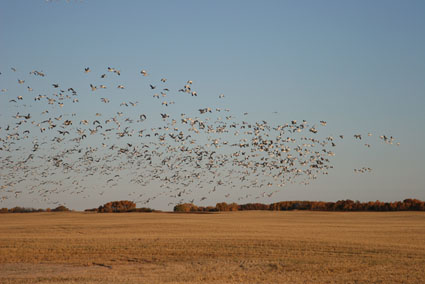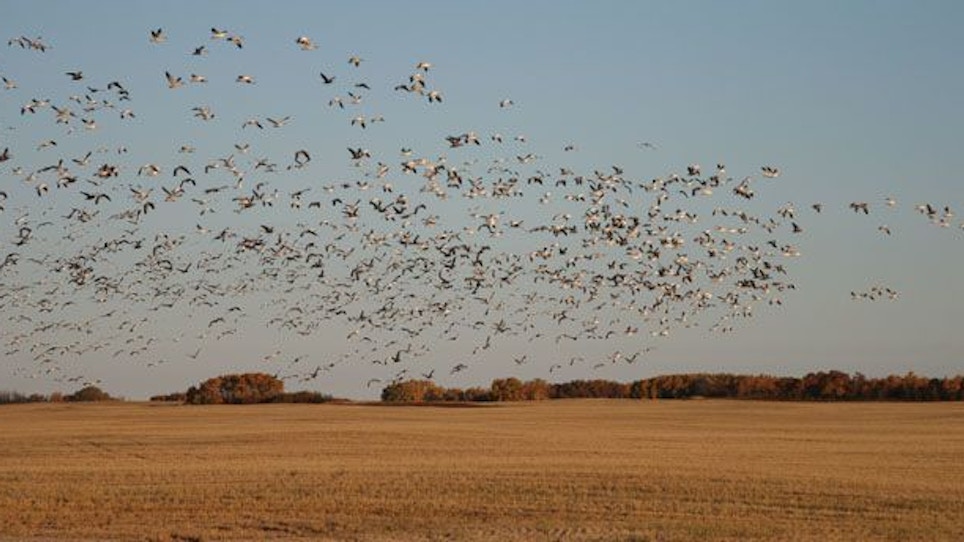 The “Welcome to Saskatchewan” sign flew by in a blur.
The “Welcome to Saskatchewan” sign flew by in a blur.
Mike Checkett had our Suburban cruising at over 70 miles per hour. The road ahead was flat and boring, though taking us straight to the heart of the Promised Land for waterfowlers — or so we hoped! We had a max load of decoys, layout blinds, retrievers, boots, shotguns and other gear, and we were giddy at the prospect of roaming like vagabonds in search of ducks and geese.
Checkett and I were in Canada to tape an episode of “Ducks Unlimited TV,” which we co-host. Our plan was to freelance hunt through the southern half of Saskatchewan. We’d scout for birds, ask permission and set up where we found prospects for good shooting. We’d be on our own for the next several days, and our viewers would share in our successes and failures.
But this wasn’t our first prairie-waterfowl rodeo! Checkett and I both have freelanced extensively in Canada and North and South Dakota. On this trip we intended to combine our know-how to show other hunters that they can do likewise with a high expectation for success.
Following is a checklist that Mike and I used when planning our freelance hunt on the northern prairie. Other hunters might follow our playbook in arranging their own hunts to intercept waterfowl as they stage for their fall migration.
Where To Go
Freelance-hunting possibilities exist from northern Alberta, Saskatchewan and Manitoba down into both Dakotas, Montana and other northern-tier states. How does a hunter pinpoint one particular area in which to focus his efforts?
It takes methodical research. Talk to friends who have hunted in various areas. Read articles in magazines and on the Internet. Calls biologists to ask about major staging areas for geese and ducks. Delve into all possible info sources, keeping in mind such things as species you want to hunt, hunter pressure, accessibility, etc. And finally, make a choice of an area that will be your starting point.
Chances are, once you get there, you’ll wind up hunting somewhere else. In several trips to Canada, I don’t think I’ve ever stuck with my original game plan. Instead, I’ve expanded into new territory once I’ve had a look at on-site hunting potential. But you need a starting point, and you also need the versatility to make a change when you find some place that’s more promising.
Over the years my best hunts have come in places that didn’t have as many birds as other, better-known locations that received a lot of publicity. Even in the North Country, hunter pressure can be heavy and competition between hunting parties intense. So for the first two or three days of a trip, I’ll check out the edges of popular hunting regions or move to a new area entirely if I’m running into too many other hunters. This strategy has paid off in many spectacular hunts with no competition whatsoever.
Finally, nothing works better than making contact with local farmers and asking their help/advice in locating birds.
When To Go
The timing of a hunting trip on the prairies is something of a crapshoot. Go early (mid-to late September), and lingering balmy conditions can result in a delay of birds concentrating for fall migrations. Time it too late (late October, early November), and cold weather might have already pushed waterfowl south.
My pick for most consistent hunting is the middle two weeks of October for Canada and the last week of October and the first week of November for the Dakotas. These are times when average peak numbers of birds are highest in these areas. Still, atypical weather conditions can play havoc with normal migration schedules.
What To Take
Equipping yourself properly is crucial to the success of any hunting trip, and this is especially true about hunting on the northern prairies.
The first requirement is a vehicle capable of covering a lot of country, including treacherous back roads, and hauling heavy loads. This typically means a full-size SUV or a pickup with a bed cover. Four-wheel-drive is a necessity for accessing hard-to-reach spots in muddy or snowy conditions.
Many hunters pull fully enclosed trailers to carry decoys and other gear and to provide security for these items when staying at motels. (Unfortunately, hunters who leave their decoys in open trailers or pickup beds might wake up the next morning to find them gone!)
If you’re considering hunting on large lakes or rivers, you should take a boat that’s big enough to ply such waters safely. Such a boat can be trailered or car-topped. Also, a reliable outboard motor, gas can, PFDs and other essentials should be included. If a boat is trailered, a portable blind might be attached for providing extra cover for hunting in reeds, cattails or other natural cover.
Decoys are a huge consideration. For goose hunting, shell decoys and silhouettes are preferable because they can be transported in more compact spaces. This means hunters can carry greater numbers of shells and silhouettes in their vehicles/trailers, and numbers are important. Generally, more decoys translate into better shooting on geese and, to a lesser extent, on ducks.
On our trip, Mike Checkett and I took several dozen Canada and snow goose shells, three dozen duck floaters, a dozen full-body duck field decoys, and a dozen full-body specklebelly decoys. This collection gave us the versatility to hunt geese and ducks in fields and over water. Instead of targeting one species, we decided to prepare for any possibilities. We didn’t have too much of anything, but we had enough of everything.
Other must-have gear items include shotguns (take a spare in case of a malfunction), ammo, a laydown blind for each hunter, waders, calls, a rake for gathering stubble to camouflage the blinds, GPS, binocular and other gear regularly used at home. Pack clothing items for hunting in weather that can be warm or bone-chilling, dry or rainy/snowy.
Aside from hunting gear, freelance hunters obviously need hunting licenses. In most states and provinces, these are available online. (Alberta is an exception.) Hunters will also need firearms permits (see sidebar) and maps of chosen hunting areas. These latter items should show back roads and section roads that are crucial for navigating out-of-the-way areas. These maps are available through a variety of sources. Start early in your trip planning to locate and purchase them.
Stay tuned for Part II!






